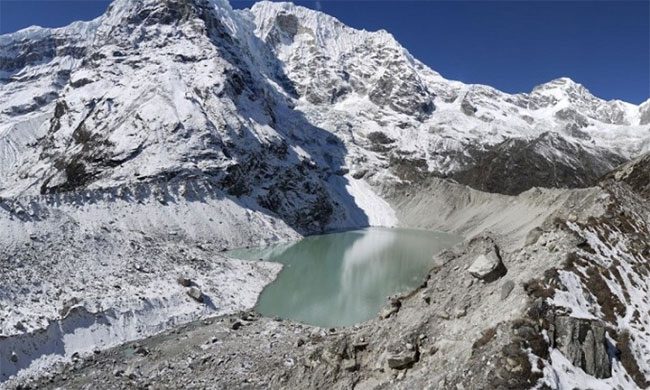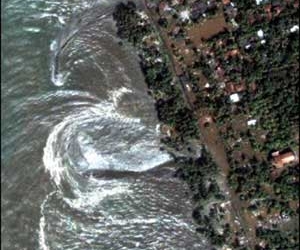Inland “tsunami” events pose a danger to communities and can damage infrastructure as glacial lakes formed by melting glaciers overflow their banks.
Glaciers around the world are melting at an alarming rate, creating massive lakes. Meltwater fills depressions left by glaciers, forming glacial lakes. As temperatures rise and more glaciers melt, lake levels increase, threatening the lives of those living downstream. If the water level rises too high or surrounding land erodes, the lake can breach its banks, sending water and debris cascading down the mountainside.

Dig Tsho Lake in the Langmoche Valley, Khumbu Himal, Nepal. (Photo: Matthew Westoby/Springer Nature).
This phenomenon is referred to as glacial lake outburst flooding. According to a study published on February 7 in the journal Nature Communications, approximately 15 million people worldwide live within 48 kilometers of glaciers that may be at risk. More than half of these individuals are concentrated in four countries: India, Pakistan, Peru, and China. This is the first study to specifically examine the potential impacts of glacial lake outburst flooding.
Tom Robinson, a lecturer at the University of Canterbury in New Zealand and a co-author of the study, likens glacial lake outburst flooding to a “tsunami inland.” He compares its impact to that of a sudden dam failure. “For example, if the Hoover Dam were still standing, you would have a massive lake behind it. But if the Hoover Dam were to suddenly be removed, the water would need an outlet. It would rush down the valley, creating gigantic flood waves,” Robinson said.
Such floods occur with little or no warning. Previous glacial lake outbursts have killed thousands and destroyed homes and critical infrastructure. The Cordillera Blanca mountain range in Peru is a hotspot for this dangerous phenomenon. Since 1941, the range has experienced more than 30 glacial disasters, from landslides to lake outbursts, claiming over 15,000 lives.
While researchers are still unclear about the extent to which last year’s floods in Pakistan were related to melting glaciers, the country has more glaciers than anywhere else in the world outside the polar regions. In 2022 alone, there were at least 16 incidents of glacial lake outburst flooding in the Gilgit-Baltistan region of northern Pakistan, far exceeding the 5-6 incidents in previous years. The study found that the most vulnerable areas to glacial lake outbursts are the high mountain regions of Asia, including Nepal, Pakistan, and Kazakhstan. On average, individuals in these regions live within 9.7 kilometers of a glacial lake.
According to Robinson, the Andes mountains, including Peru and Bolivia, are among the most concerning areas due to the lack of research conducted in the region. The research team emphasizes that over the past two decades, glaciers in the Andes have been melting faster due to climate change, creating massive glacial lakes that increase the flood threat from outbursts. North America and the European Alps are not high-risk areas as few people live near glacial lakes.
Melting glaciers are one of the most visible and apparent signs of the climate crisis. A recent study by David Rounce, a glaciologist at Carnegie Mellon University, found that half of the world’s glaciers could disappear by the end of the century, even if the world meets climate change mitigation goals such as phasing out fossil fuels. As temperatures continue to rise, Robinson hopes that his research and that of his colleagues can help global leaders identify which countries need early warning systems for flooding caused by melting glaciers.





















































